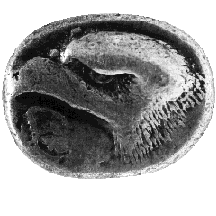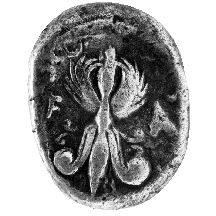



(31) Olympia, Elis (Greece) - AR stater, c. 400-380 B.C.,
12.08 g. (inv. 91.073).
Obverse: Eagle's head l., poplar leaf below.
Reverse: Thunderbolt with wings on one end and volutes
on the other, the whole in olive wreath; ![]() : abbreviation for
: abbreviation for ![]() , an archaistic spelling for "of
the Eleians."
, an archaistic spelling for "of
the Eleians."
Provenance: Spink and Son, 1972.
Bibliography: C. Seltman, The Temple Coins of Olympia
(Cambridge 1921) 154.
The city of Elis was founded in 471 B.C. as a result of the synoecism
or merger of neighboring towns. Its importance as a mint in the Classical
period stemmed from its control of the festival games at the sanctuary of
Zeus and Hera at Olympia. From the time of its foundation until it became
dependent upon Macedon at the end of the fourth century B.C., it issued
a series of silver staters of high artistic quality that should probably
be seen more as souvenirs of the festival than as the normal trade coinage
of Elis. Two mints have been identified with this coinage, one under the
charge of the Temple of Zeus issuing obverse types with attributes of Zeus
and, from the end of the fifth century B.C., a second mint attached to the
Temple of Hera producing coins with obverse types related to her (see no.
32).
The most common types for the staters of the fifth and early fourth centuries
were a number of different versions of the primary symbols associated with
Zeus, the eagle and the thunderbolt. The obverse of this coin depicts a
magnificent eagle's head, and beneath it a poplar leaf. Although not legible
on this coin, in other examples of this die the letters DA, possibly an
artist's signature, are visible in the center of the leaf.
R.H.L.



All contents copyright (c) 1996.
Lawrence University
All rights reserved.